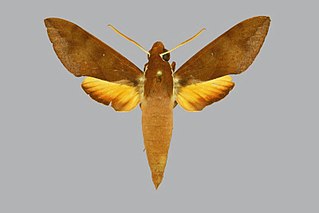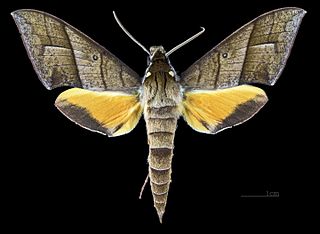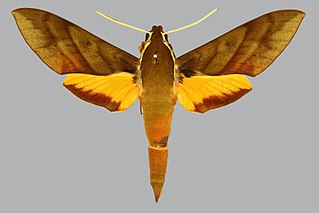
Theretra oldenlandiae, the impatiens hawkmoth, taro hornworm or white-banded hunter hawkmoth, is a member of the family Sphingidae.

Gnathothlibus erotus, the white-brow hawkmoth, is a moth of the family Sphingidae. The species was first described by Pieter Cramer in 1777.
Bernard d'Abrera was an Australian entomological taxonomist and philosopher of science, particularly noted for his books on true butterflies (Papilionoidea) and larger moths of the world. Referred to as one of the world's best-known lepidopterists by The Daily Telegraph, his work since 1982 was openly critical of evolution.
Robert Herbert Carcasson was an English entomologist who specialised in butterflies, but also authored two field guides to tropical fishes. He joined the Coryndon Museum, Nairobi, as senior entomologist in 1956. He then became its director, under the museum's new name of the Natural History Museum from 1961 to 1968. During this time, he was awarded a PhD for his studies on African hawkmoths. From 1969 to 1971 he was Chief Curator of the Centennial Museum, Vancouver, Canada. In 1972 he travelled in Polynesia, Melanesia, Australia, Malaysia, Sri Lanka, Seychelles and East Africa for production of two field guides to coral reef fish of the Indo-Pacific region. From 1973 to 1979 he was Curator of Entomology at the Museum of British Columbia. He died of cancer. Somewhat a polymath, he was fluent in a number of languages, and produced the illustrations to a number of his works, culminating in hundreds of colour and line drawings of fishes for his reef fish field guides.
Philodila is a genus of moths in the family Sphingidae first described by Walter Rothschild and Karl Jordan in 1903. Its only species, Philodila astyanor, described by Jean Baptiste Boisduval in 1875, is known from the Society Islands in the South Pacific Ocean.

Theretra is a genus of moths in the family Sphingidae. The genus was established by Jacob Hübner in 1819.

Gnathothlibus is a genus of moths in the family Sphingidae.
Theretra tabubilensis is a moth of the family Sphingidae first described by Robert B. Lachlan in 2009. It is known from New Guinea.
Gnathothlibus australiensis is a moth of the family Sphingidae. It is known from the Northern Territory and Queensland.
Gnathothlibus fijiensis is a moth of the family Sphingidae. It is known from Fiji.

Gnathothlibus brendelli is a moth of the family Sphingidae. It is known from Sulawesi.

Gnathothlibus collardi is a moth of the family Sphingidae. It is a hybrid between a female Philodila astyanor and a male Gnathothlibus eras. It is known from Tahiti.

Gnathothlibus dabrera is a moth of the family Sphingidae. It is known from Sulawesi.

Gnathothlibus eras is a moth of the family Sphingidae.

Gnathothlibus heliodes is a moth of the family Sphingidae. It is known from Papua New Guinea and some adjacent islands.

Gnathothlibus meeki is a moth of the family Sphingidae. It is known from Papua New Guinea. It prefers mountainous areas.

Gnathothlibus saccoi is a moth of the family Sphingidae. It is known from Vanuatu.

Gnathothlibus vanuatuensis is a moth of the family Sphingidae that is endemic to Vanuatu.
Theretra papuensis is a moth of the family Sphingidae. It is known from Pantar in New Guinea.











